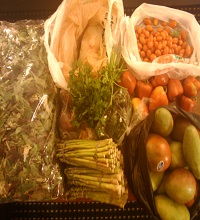Fresh Homemade Ricotta Cheese
April 7th, 2020
Prep Time: 01 hour
Cook Time: 0:00
Ricotta "Cheese" is not technically a cheese, but actually a cheese byproduct. Fresh Ricotta is surprisingly easy to make, once you learn a few tricks. In less than an hour, you can go from a Gallon of Whole Milk to fresh Ricotta.
Ingredients:
==========
1 Gallon Whole Milk
1.5 Teaspoons Citric Acid
Non-Iodized Salt
A few ounces of drinking water
The Milk:
Do not use milk that is past (or nearing) the expiration date. You will want to have full control over the bacteria present, with no naturally occurring cultures. You can use Pasteurized milk, but do not use Ultra High Temperature (UHT) Pasteurized milk. I have never attempted to make any cheese using raw milk, but I know that it can be done. Always ensure that you use safe practices and that you sanitize all of your tools and your work space before you begin.
Tools:
Small glass or small bowl, able to hold 1/4 Cup of liquid
Large non-reactive cooking pot with a lid (I prefer to use an enamel-lined cast iron pot, since it maintains temperature well)
Another large pot
Instant-read Thermometer
Large plastic Colander or Large Mesh Sieve
Paper Towels
Large Coffee Filters
Large Wooden or Large Plastic Spoon
Large Glass or Large Plastic Bowl
Directions:
=========
Sanitize all your tools and work space.
Dissolve the Citric Acid into 1 or 2 ounces of drinking water in the small glass bowl.
1. Heat the Milk
In a large non-reactive pot, mix the milk with the Citric Acid and then heat to exactly 90° Fahrenheit.
2. Rest the Milk
Remove from the heat, stir again briefly, then cover.
Allow the milk to sit and cool for 15 minutes or up to about an hour. The curds and the whey should begin to separate.
3. Heat the Curds
Place the curds and whey back on the stove and heat until the temperature hits 185° Fahrenheit
4. Strain the Curds from the Whey
Remove the pot from the stove.
Take the Colander or the sieve. Line it with 2 layers of paper towels.
Place the Colander or Sieve over the large glass bowl to catch the whey.
Use the large spoon and move the curds into the Colander or Sieve.
Drain the whey (liquid) from the curds (solid).
Stir and press the curds with the spoon to help drain more whey.
Additional whey can be forced from the curds by wrapping the curds tightly in Coffee Filters and then gently squeezing the bundle.
Retain the whey as it drains into the bowl.
Continue to squeeze and work with the curds to drain out as much whey as possible. Mix Sea salt into the Curd.
Store refrigerated for up to 2 weeks

